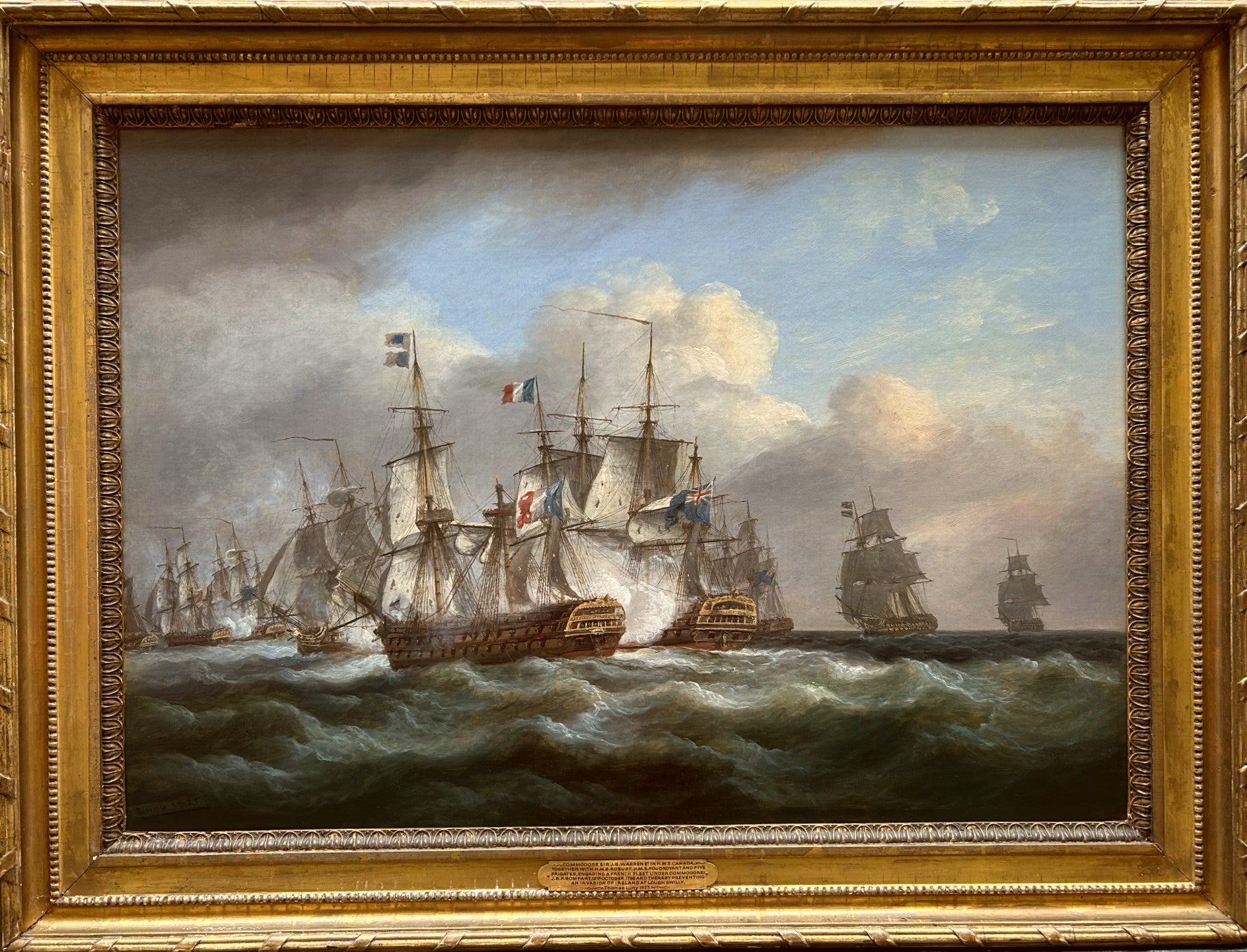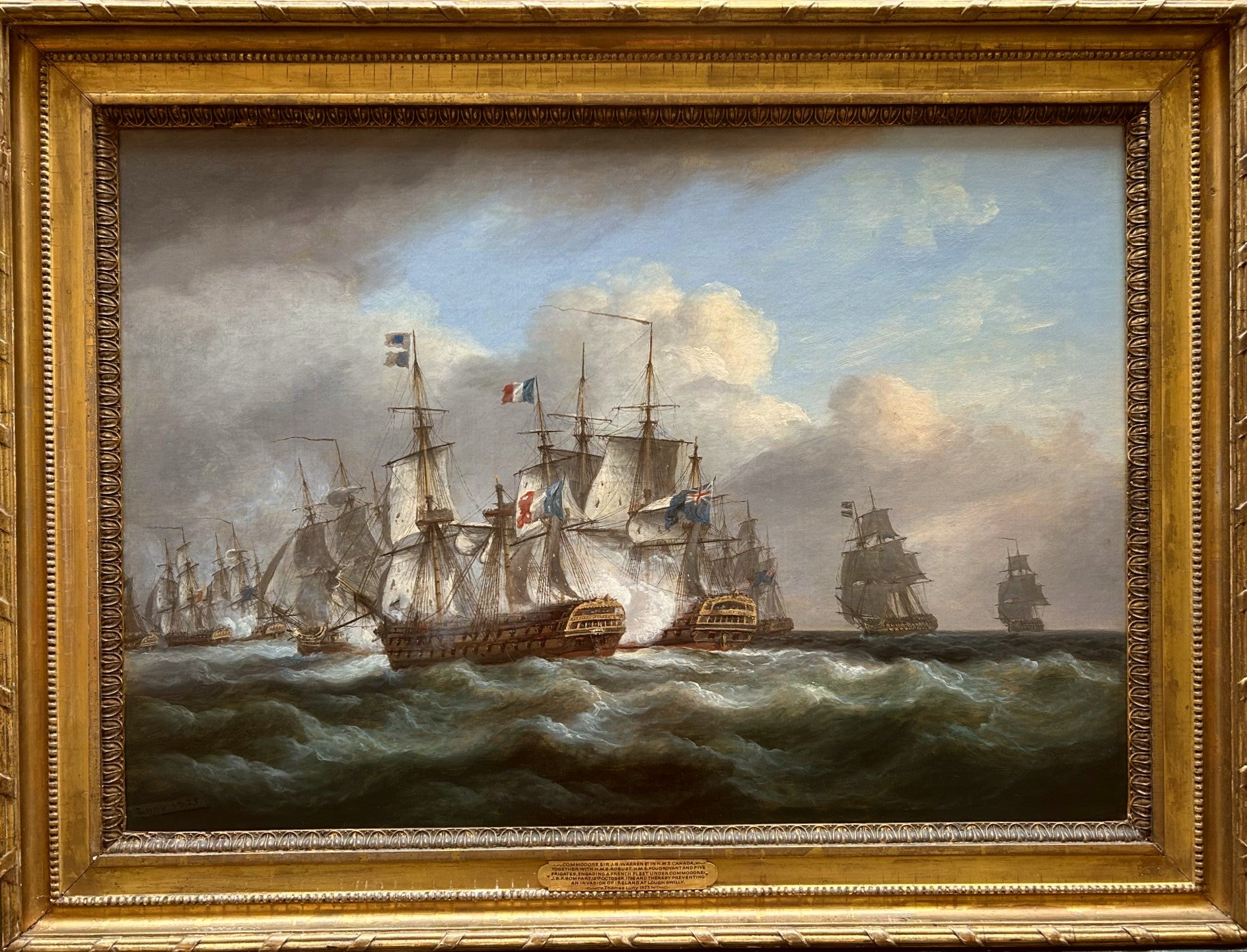

Thomas Luny
Battle of Tory Island
Oil on Canvas, signed and dated '1825' lower left
Image Size: 34 x 23 1/2 inches (86.5 x 59.5 cm)
Handmade gilt frame
Provenance
Christie's, 1880 (sold for 32 guineas)
Private collection
Christie's, 1976
The Parker Gallery
Private Collection
This painting is of Commodore Sir J.B. Warren BT in H.M.S Canada together with H.M.S Robust, H.M.S Foudroyant and five frigates, engaging a French fleet under commodore J.B.F. Bompart, 12th October, 1798 and thereby preventing an invasion of Ireland and Lough Swilly.
Britain’s enemies in Europe had long recognised Ireland as a weak point in Britain’s defences. The attempt by the French during the French revolutionary Wars to land troops in Ireland in 1798 as depicted here became known as the Battle of Tory Island.
The Society of United Irishmen, led by Wolfe Tone, launched an uprising against British rule in Ireland in May of 1798. At the request of the rebels, a small French force under General Humbert was landed in Killala, County Mayo but by early September both the expedition and the rebellion had been defeated. Unaware of the French surrender in Killala, the French dispatched reinforcements on the 16th of September under the command of Commodore Jean-Baptiste-Francois Bompart. The British Navy now on high alert after failing to intercept the previous French fleet spotted the fleet soon after they left Brest and after a long chase the French were brought to battle off of the County Donegal coast, very close to Tory Island. Over the space of two weeks, British frigate captured seven ships, scattering the survivors. Of the ten ships in the original French squadron only two frigates and a schooner reached safety while British losses were minimal.
The battle marked the last attempt by the French Navy to launch an invasion on any part of the British Isles, simultaneously ending the last hopes the United Irishmen had of obtaining outside support in their
struggle with the British. While aboard a captured French ship, Tone was recognised and arrested. He was later tried for treason, convicted, and committed suicide while in prison in Dublin, hours before he was to be hanged.
Thomas Luny
Born in Cornwall, Thomas Luny was an English artist who primarily painted maritime scenes and seascapes.
Leaving for London in 1759, Luny became the apprentice of Francis Holman, a marine painter famous for his patriotic scenes of sea battles. Here, Luny developed his practice, with the lasting impressions left by Holman evident in Luny’s later maritime works through compositional and stylistic preferences. Luny temporarily left Holman’s studio in September 1777 to travel around France and to exhibit his painting “A Distant View of the Island of Madeira and Porto Santo” at the Society of Artists that same year, before returning to Holman’s studio. In 1780, he set up his own practice on Leadenhall Street in 1783.
Between 1780 and 1802, Luny exhibited twenty-nine times, and his work was frequently shown at the Royal Academy. With the success of his work, Luny used the money he earned to regularly invest in government stocks, helping to solidify his financial success as an artist.
His popularity was further accelerated by his studio’s position on Leadenhall Street, with its close proximity to the British East India Company’s headquarters leading to many commissions of paintings and portraits. This relationship was further beneficial to Luny, who is believed to have been invited on the company's ships, leading to his detailed and realistic sketches of locations within Europe and the Americas. Additionally, the location of his studio on Leadenhall Street developed a close relationship between Luny and an art dealer and framer called Mr. Merle, in which both parties promoted each other's work for over twenty years.
In 1807, several years later, Luny moved his studio again to Devon, where he received a number of commissions and continued to capture the same popularity that he experienced in London. Between 1808 and 1809, Luny solidified his position in Teignmouth, Devon, by building a house on the harbor front in Teign Street, which, while becoming known as Luny House, served as a significant part of his work in his later years. Though he was suffering from arthritis at this time in both of his hands, there was no obvious impact on his work due to his technique of strapping the paintbrush to his wrist, and he continued to be prolific, producing over 2,000 paintings during his time in Devon.
Luny died on the 30th of September, 1837, and was buried in the graveyard of St. James’ Church in Devon.
Exhibitions
Royal Academy of Art
Society of Artists
Museums
National maritime Museum, Greenwich
Royal Albert Memorial Museum, Exeter
Mariners’ Museum, Virginia
Victoria and Albert Museum, London
Tate Gallery, London
Walker Art Gallery, Liverpool
National Gallery of Victoria, Australia

